This pumpkin sourdough bread has a delightful balance between the tang of sourdough and the natural sweetness of pumpkin. What makes it even more enticing is that this pumpkin-infused bread is shaped like its namesake - a pumpkin itself.
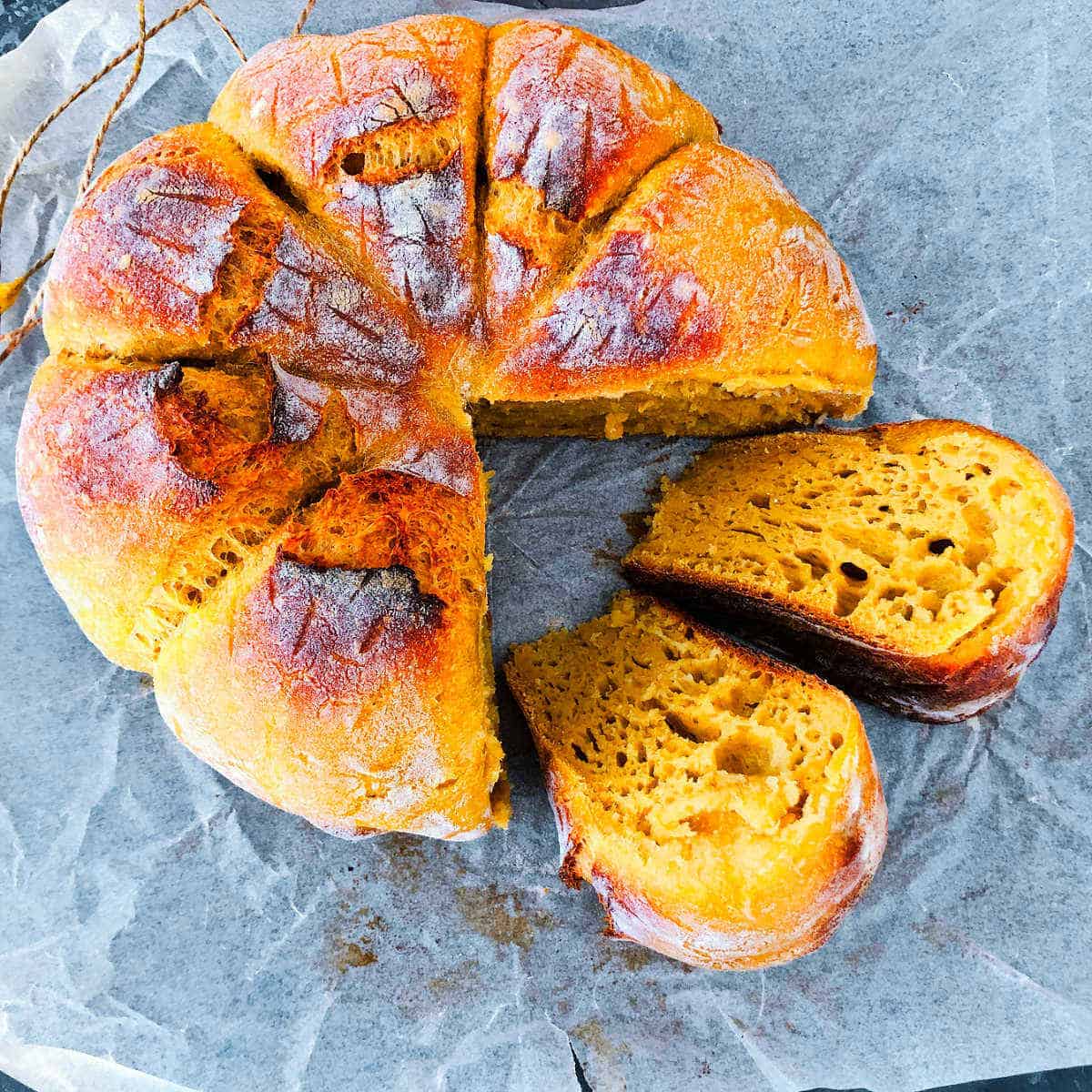
Pumpkin sourdough bread is perfect for fall. It is also a great way to use up leftover pumpkin puree. The bread is moist and flavorful, with a hint of sweetness from the pumpkin puree. This delicious and unique sourdough bread flavor is a must-try.
Previously, I shared my recipe for no-knead sourdough bread, and this variation is a departure from that timeless classic. I have spent numerous rounds of baking to fine-tune the precise amount of pumpkin necessary to achieve the perfect flavor profile, as well as to reduce the water content in the dough for easier handling.
Why you will love this recipe?
- This recipe of pumpkin sourdough bread is tried and tested to give you a perfect balance of the earthy richness of pumpkin and the tangy complexity of sourdough.
- Pumpkin sourdough bread combines the tangy, complex flavors of sourdough with the earthy sweetness of pumpkin.
- I am showing you how to shape the bread like a pumpkin, which adds a festive and visually appealing element.
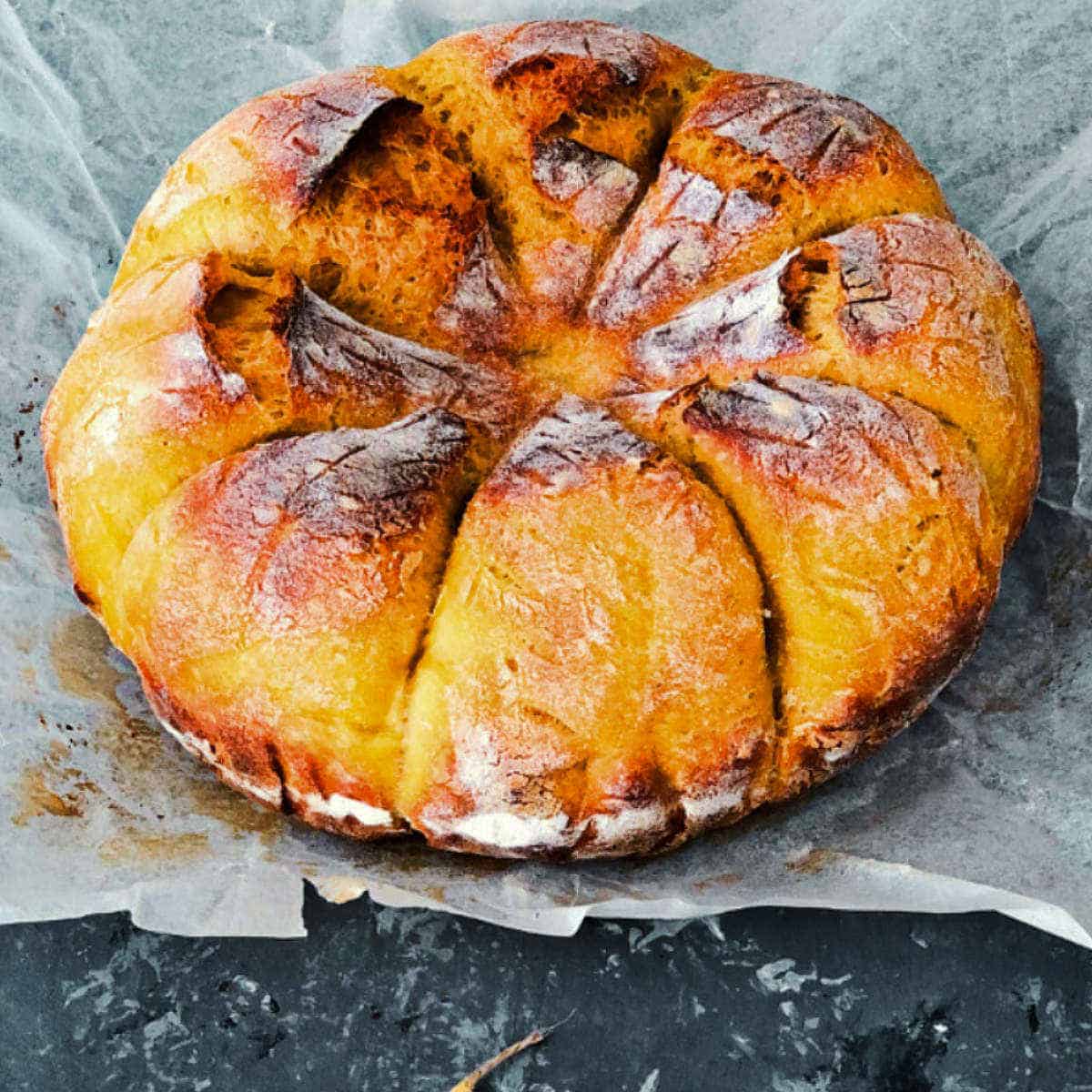
Ingredients
Sourdough starter: This is the key ingredient to make any sourdough recipe. Make sure the starter is active and bubbly.
Pumpkin: Peel and cut the pumpkin into cubes to make homemade puree. You can either make your own pumpkin puree or use canned pumpkin puree.
See the recipe card for full information on ingredients and quantities.
Variations
Pumpkin pie spice: Add pumpkin pie spice like cinnamon, nutmeg, and cloves to the dough. The pumpkin spice flavors will be reminiscent of fall desserts.
Pumpkin cranberry bread: Incorporate dried cranberries into the dough for a sweet-tart contrast to the pumpkin's sweetness.
Pumpkin seeds: Sprinkle pumpkin seeds (pepitas) on top of the loaf for added visual appeal and a nutty flavor.
Step-by-step instructions
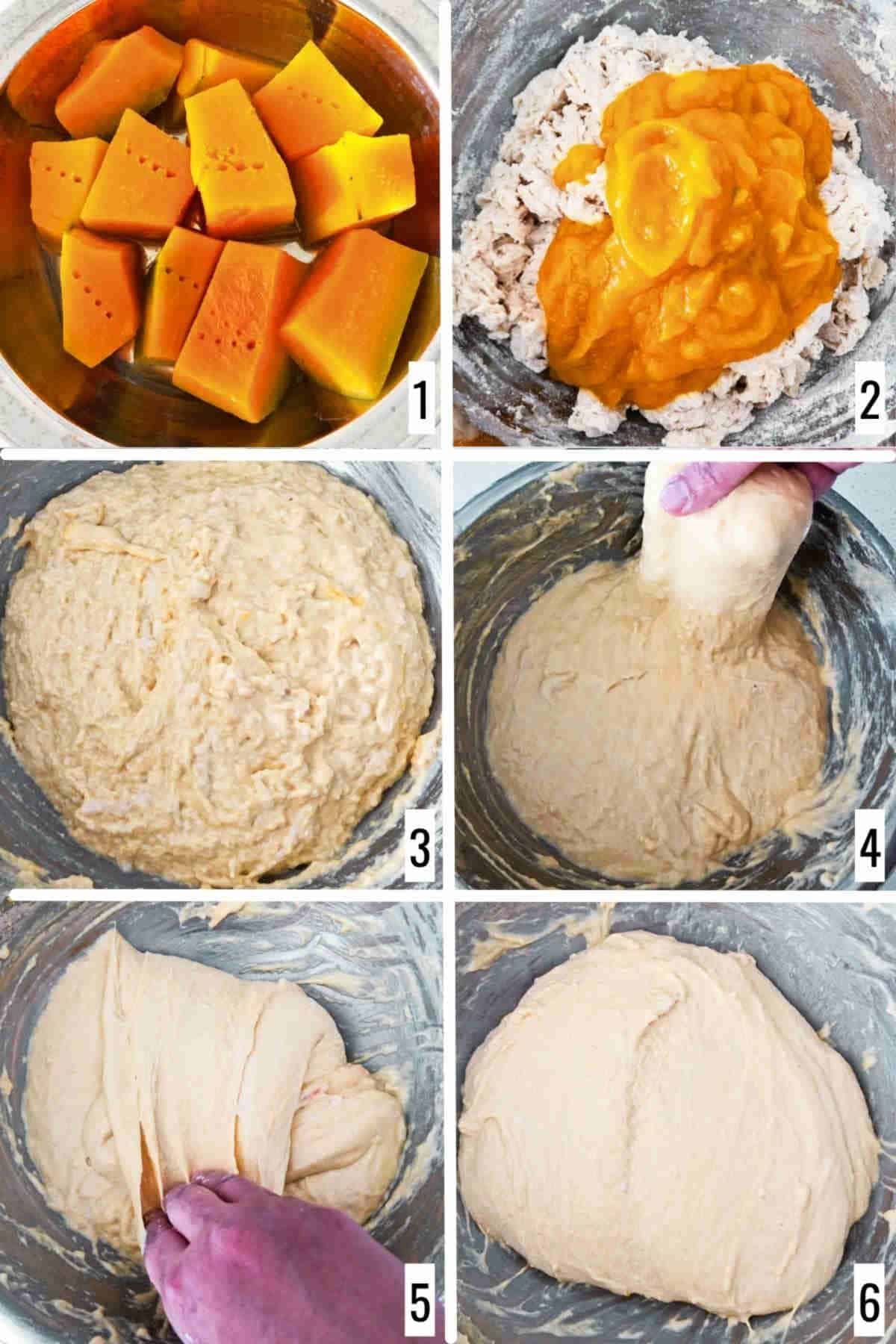
Step 1: Prick the pumpkin using a fork and steam it until completely cooked. Puree it without adding any water (image 1). If you add water while making the puree, measure it and reduce that amount of water from the recipe.
Step 2: Combine water and active starter. Slowly add the flour and mix well, making sure there are no dry bits of flour. Next, add salt and homemade puree to the dough. Mix well to ensure they are incorporated well. Let the dough rest for 30 minutes (images 2 and 3).
Step 3: Once the dough has rested, begin the stretch and fold technique. Gently pull the dough to perform stretch and fold. Gently stretch the edge of the dough and fold it back to the top of the dough (images 4 and 5). Cover and let it rest for 30 minutes (image 6).
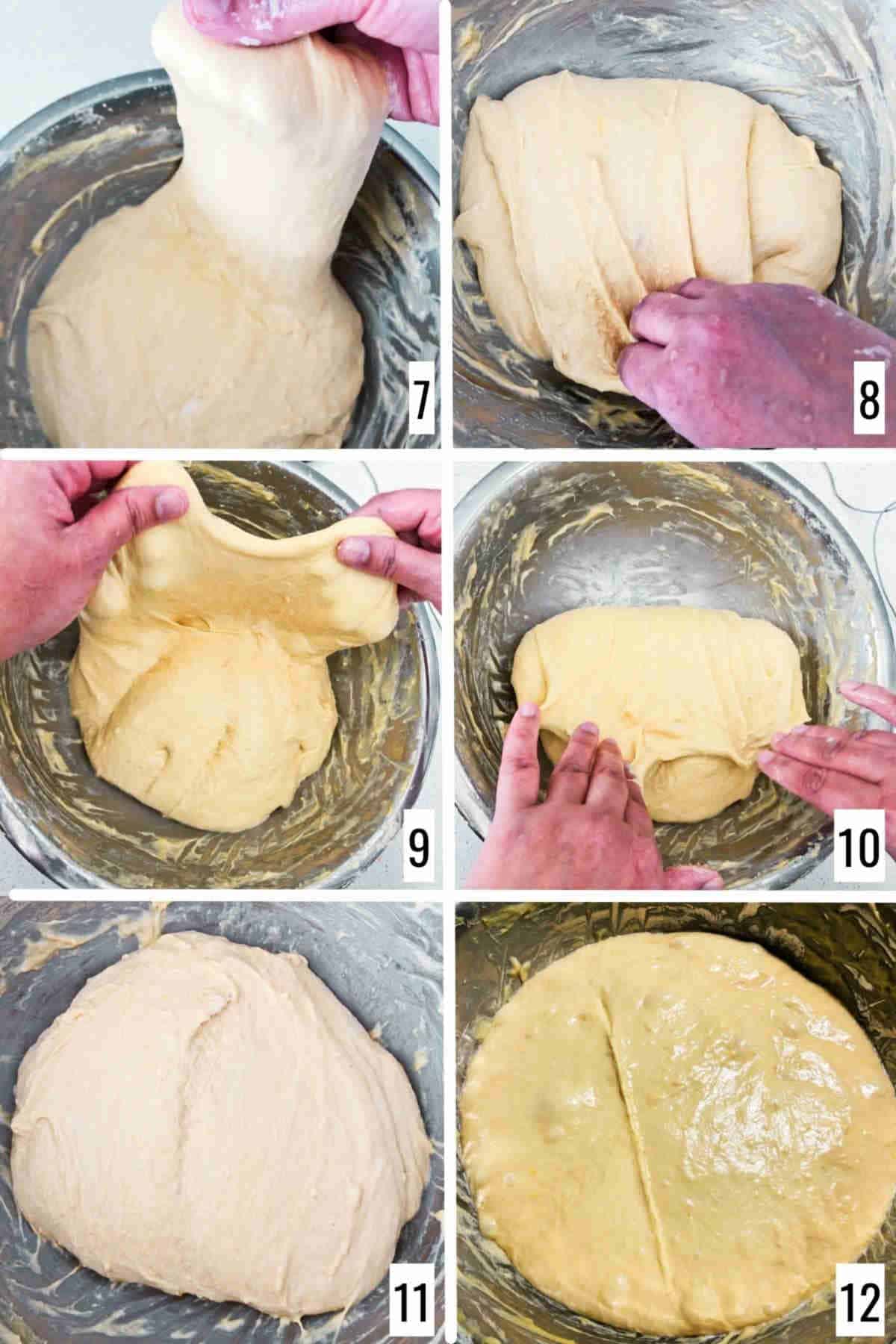
Step 4: Continue to stretch and fold the dough, doing a quarter turn of the bowl after each dough rest. Gently stretch the edges of the dough and fold it back to the center of the dough (images 7 and 8).
Step 5: The dough develops gluten and builds strength and structure with every stretch and fold (images 9 and 10).
Step 6: Let the dough sit for bulk fermentation (image 11). The time this takes depends on the ambient temperature of your kitchen, so go by the feel of the dough rather than the time. After bulk fermentation, the dough rises almost double (image 12).
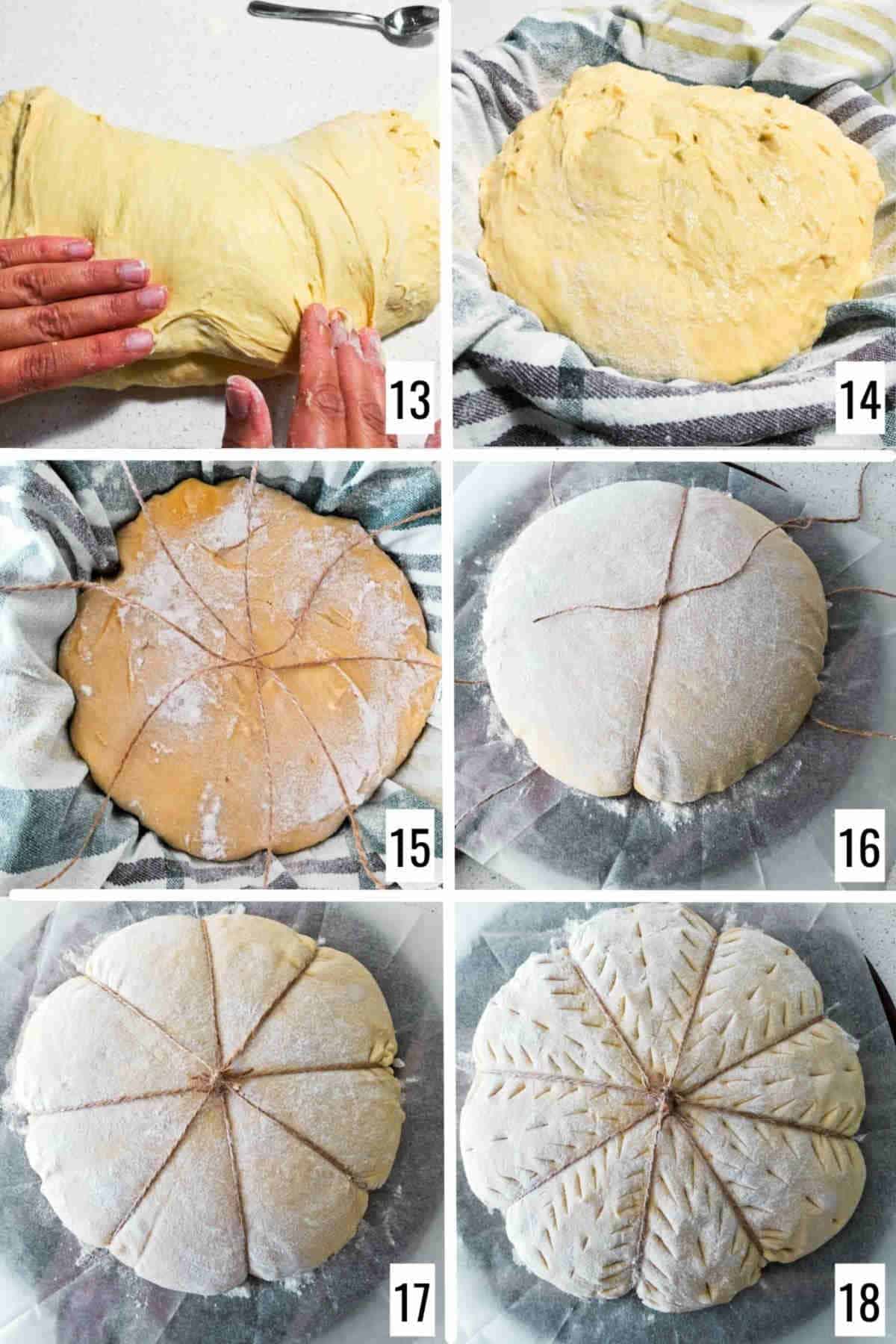
Step 7: After bulk fermentation and dough rise, flip the dough onto a lightly floured work surface. Pick one side of the dough and fold it to the center. Pick the other side and fold it to the center. Now, hold the dough gently and tuck it to form a dough ball. Carefully place the shaped dough seam side up on the banneton or proofing basket. Cover the dough loosely with a damp kitchen towel, shower cap, or plastic bag. Place it in the refrigerator overnight for cold fermentation and a second rise (images 13 and 14).
Step 8: The next day, set the oven temperature to 450 F (230 C). Place the Dutch oven in the oven and preheat it for 45 minutes. Once the oven is preheated, take the dough out of the fridge. Cut 8 pieces of kitchen string long enough to tie the dough. Place the twine on the dough and place a baking paper (image 15).
Step 9: Flip the dough so that the twines are under the dough. Tie the twine loosely in a crisscross pattern. Cut off any excess string (images 16 and 17). Score the dough using a blade or sharp knife (image 18).
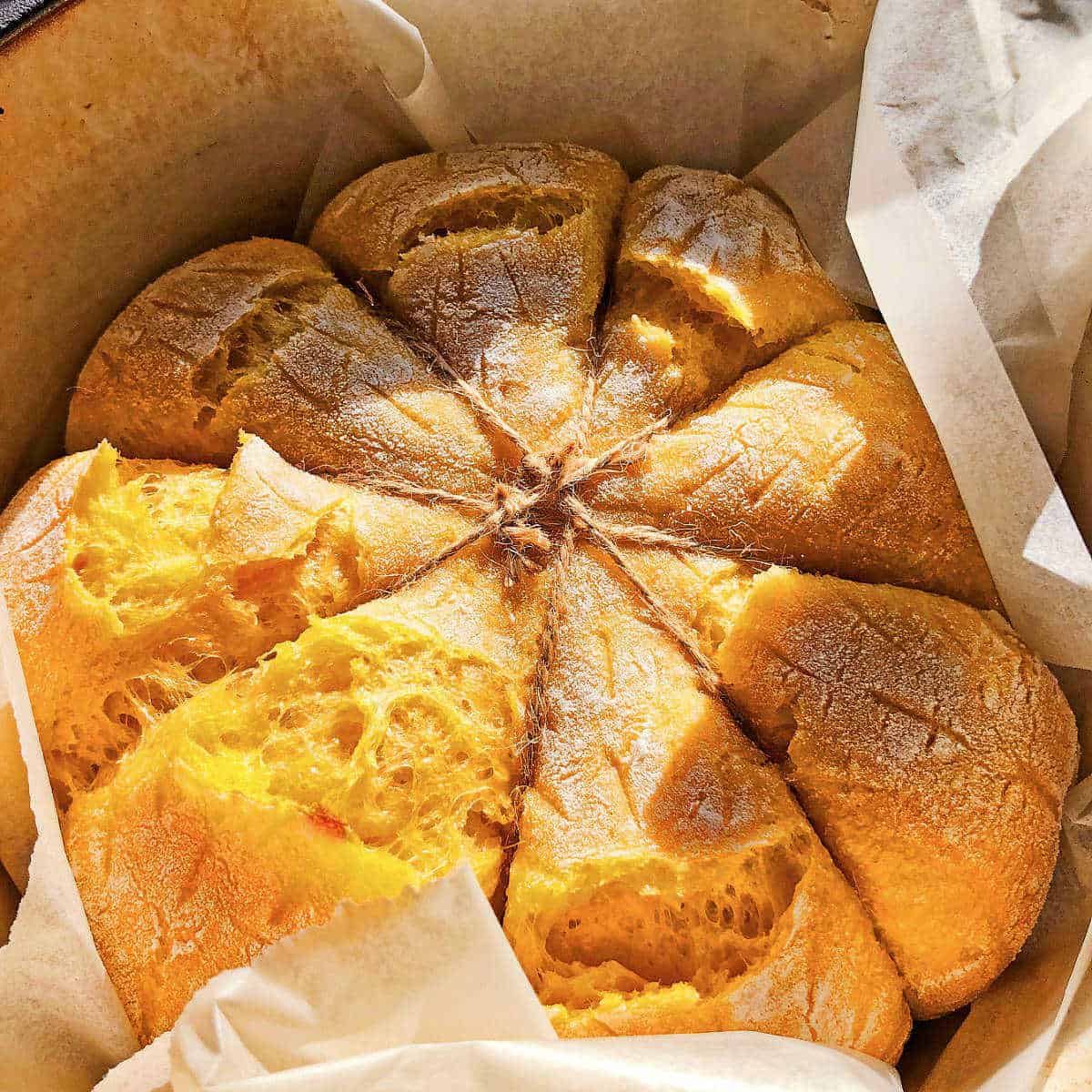
Step 10: Carefully take the covered Dutch oven out of the oven. Place the scored dough and baking paper into the hot Dutch oven and immediately close the lid. Place it back in the oven and bake for 20 minutes. Take the lid off the Dutch oven and bake for another 15 minutes until the crust is golden brown. Cut the pieces of string once the bread cools down.
Expert Tips
I have used homemade pumpkin puree for this recipe. You can also replace it with canned puree. You will need 150 grams of pumpkin puree for this recipe. Make sure to use plain pumpkin purée and not the pumpkin pie filling.
I have made this sourdough with bread flour and whole wheat flour, but you can choose any flour - for example, a combination of all-purpose flour and whole wheat flour or multigrain flour.
Ensure the sourdough starter is active. The night before you plan to make the dough, take it from the fridge and feed it in a 1:1:1 ratio of starter:flour:water.
Serving Suggestion for pumpkin sourdough bread
Serve pumpkin sourdough bread alongside a hearty soup like lentil soup or Indian chicken soup. This bread is also great as a part of the holiday charcuterie board. Pumpkin sourdough bread serves as a versatile addition to your holiday festivities.
As an edible centerpiece, bake a festive pumpkin-shaped loaf and surround it with delightful accompaniments like whipped butter, honey, maple syrup, or cranberry sauce for a visually appealing table centerpiece for your Thanksgiving table. This delicious bread is great as an edible gift, too.
Recipe FAQs
To store pumpkin sourdough bread, keep it in a cool, dry place at room temperature for up to 2-3 days. If you want to extend its freshness, store it in an airtight container or a resealable plastic bag to prevent it from drying out. For longer storage, freeze the bread by wrapping it tightly in plastic wrap and then placing it in a freezer-safe bag; it can be stored in the freezer for up to 2-3 months. When ready to enjoy, thaw the bread at room temperature or reheat it in an oven for a few minutes to restore its freshness.
Yes, you can use pumpkin sourdough bread dough to make delicious pumpkin rolls. After the dough has gone through its initial fermentation and rise, simply shape it into individual rolls, allow them to proof until they're puffy, and then bake as you would with regular dinner rolls. The result will be soft, flavorful pumpkin rolls with the unique taste of sourdough and pumpkin.

More sourdough recipes
If you tried this Pumpkin Sourdough Bread Recipe or any other recipe on my website, please leave a ? star rating and let me know how it went in the ? comments below.
Recipe card

Pumpkin Sourdough Bread
Equipment
- Bread lame or razor blade to score the dough
Ingredients
- 100 grams sourdough starter (active)
- 400 grams bread flour
- 100 grams whole wheat flour (atta)
- 320 grams filter water
- 10 grams salt
- 2 cups pumpkin (sub with 150 grams of pumpkin puree)
- Rice flour to dust the banneton
Instructions
Make the initial dough:
- Prick the pumpkin cubes using a fork. Place it in a steamer and steam it until completely cooked. Cool it completely and blend it to make a puree. Use 150 grams of pumpkin puree for this recipe.
- In a large mixing bowl, combine the active sourdough starter with water until it is fully incorporated.
- Slowly add the flour and mix well, making sure there are no dry bits of flour.
- Once the dough has rested, add the salt and pumpkin puree. Gently fold them into the dough. Let it rest for 30 minutes.
Bulk Fermentation:
- Perform six sets of stretch and fold at an interval of 30 minutes. With wet hands, grab a portion of the dough and slowly stretch it, taking care not to break it, and fold it towards the center over the dough. Keep turning the bowl and repeat the process until all parts of the dough is covered. Carefully flip the dough and round it up. This completes one set of stretch and fold. Repeat this process six times at an interval of 30 minutes.
- Let the dough sit for bulk fermentation until it is almost double and has bubbles on the top. This may take 3-4 hours depending on the ambient temperature.
Shaping and cold fermentation:
- Dust round or oval bannetons well with rice flour. Flip the dough onto a lightly floured surface.
- Pick one side of the dough and fold it to the center. Pick the other side and fold it to the center. Now, hold the dough gently and tuck it to form a log. Carefully place the dough seam-side up on the banneton.
- Cover the dough loosely and place it in the refrigerator overnight for cold fermentation and final rise.
Bake the pumpkin sourdough bread:
- The following morning, place the Dutch oven in the oven and preheat to 450 F (230 C) for 45 minutes.
- Once the oven is preheated, take the dough out of the fridge.
- Cut eight kitchen twines long enough to tie the dough. Place the twine on the dough and place a baking paper. Flip the dough so that the twines are under the dough (see image). Tie the twine loosely in a crisscross pattern (see image).
- Score the dough using a blade or sharp knife.
- Carefully take the Dutch oven out of the oven. Place the scored dough along with the baking paper into the hot Dutch oven and immediately close the lid.
- Place it back in the oven and bake for 20 minutes.
- Take the lid off the Dutch oven and bake for another 15 minutes.
- Turn off the oven and keep the door ajar. Let the bread sit in the oven for 15 minutes for curing.
- Cool completely, slice, and serve.

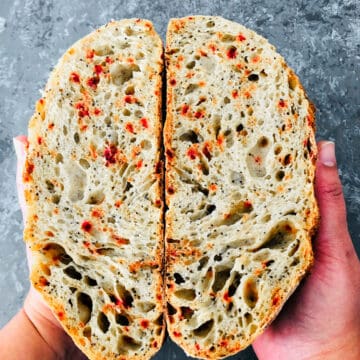
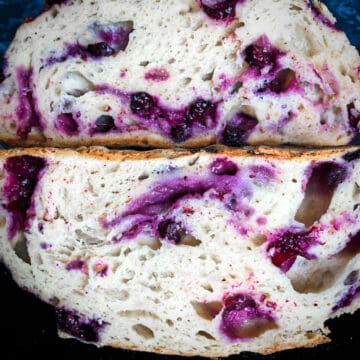
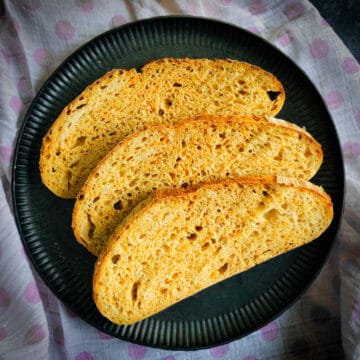
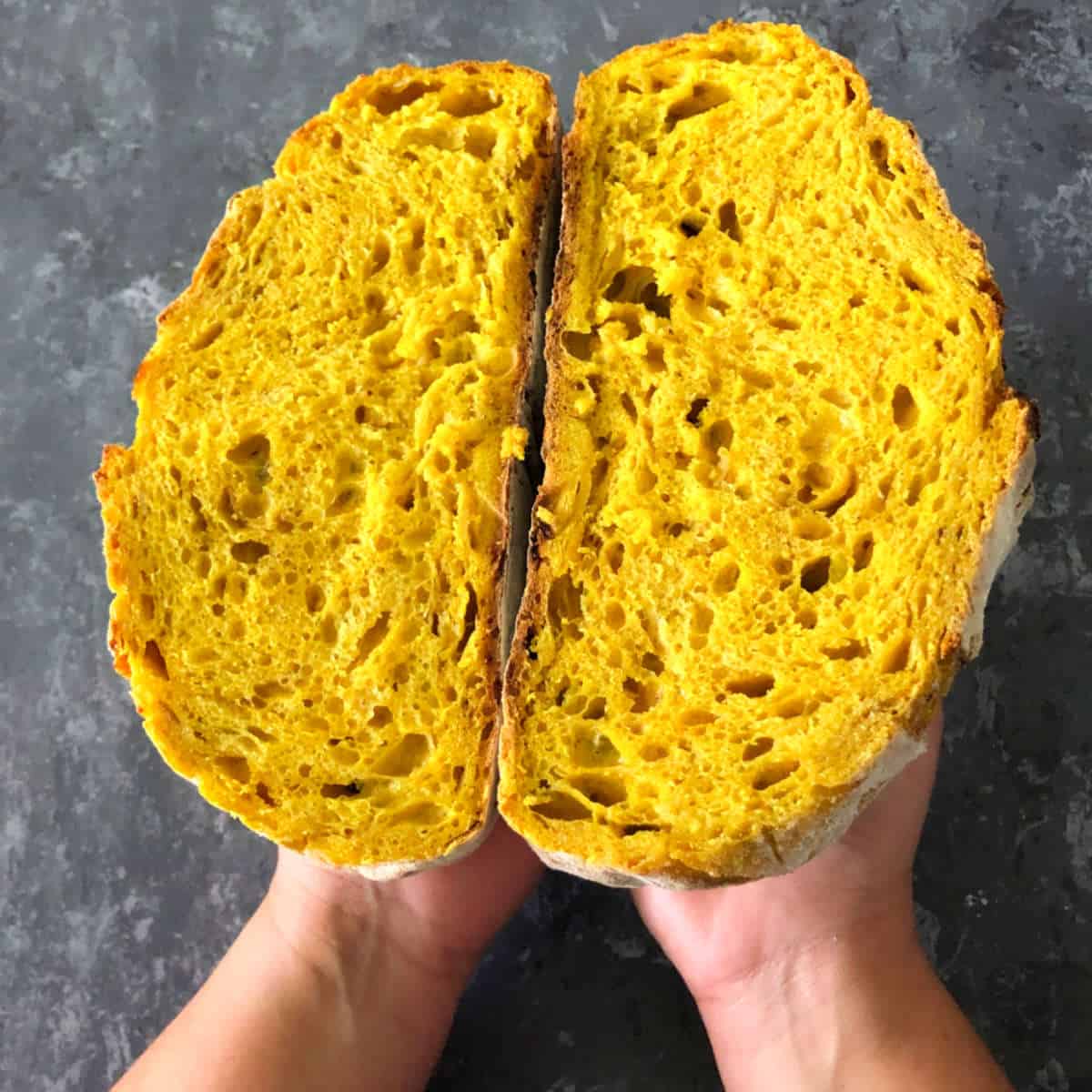
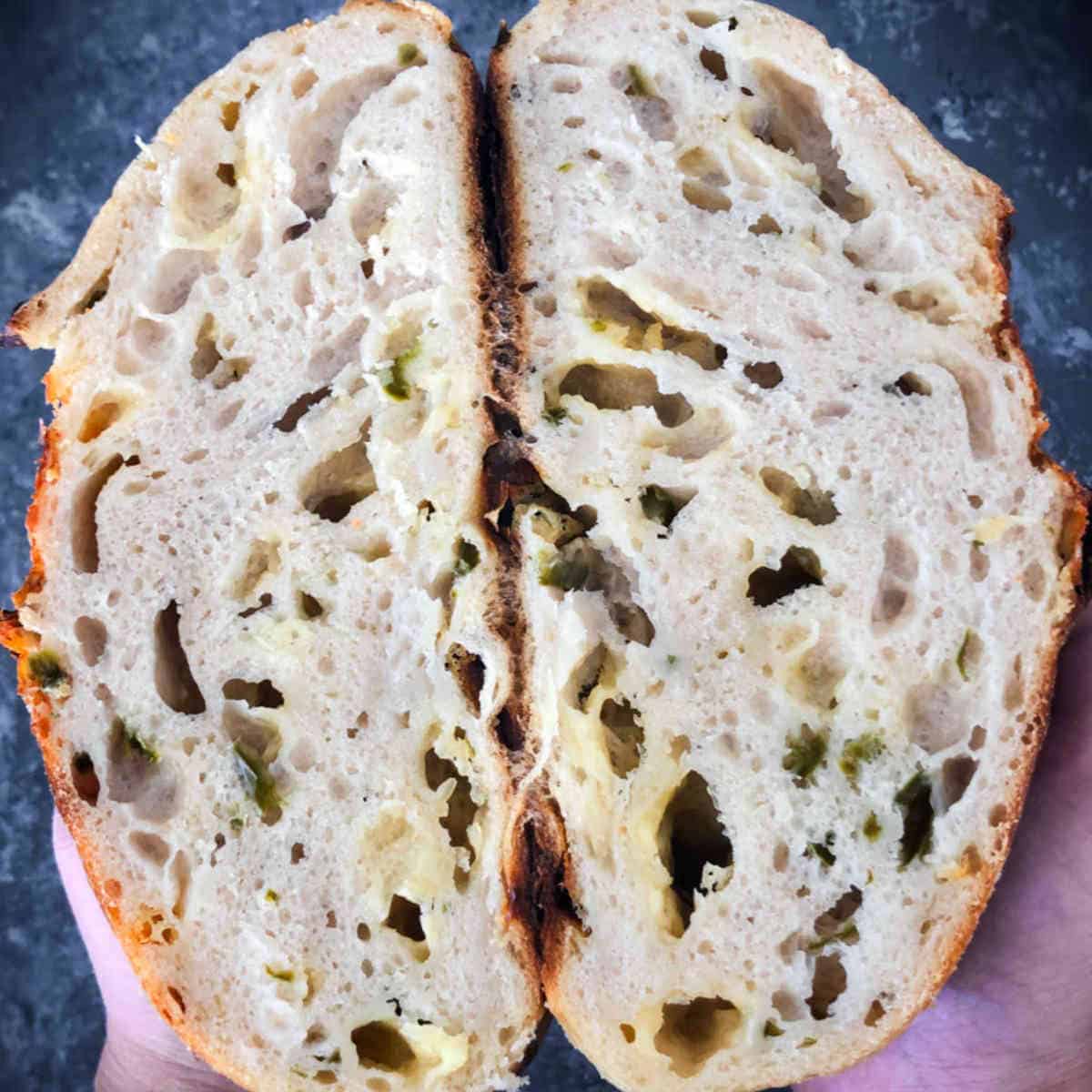
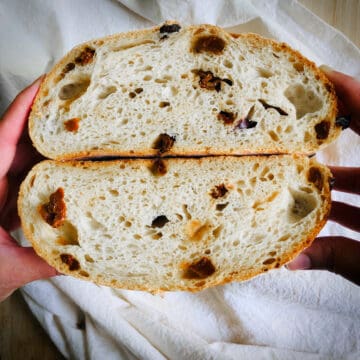
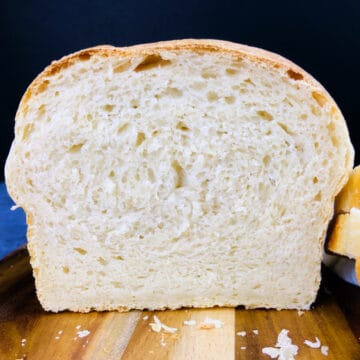
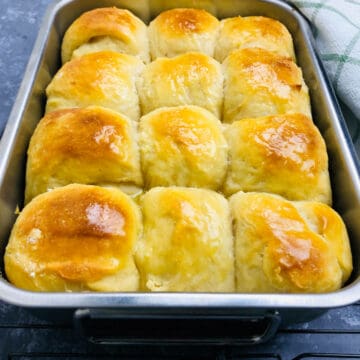
Comments
No Comments